The Osprey (Pandion haliaetus), a consummate fisherman of the avian world, emerges as a charismatic and skilled raptor renowned for its remarkable fishing abilities.
Also known as the sea hawk or fish eagle, the Osprey is a distinctive bird of prey that traverses the globe, inhabiting a range of coastal and freshwater habitats.
Equipped with specialized adaptations for piscivorous pursuits, the Osprey’s mastery of aerial hunting is accentuated by its reversible outer toes, enabling a powerful grip on slippery fish.
Its striking appearance, marked by a white head, dark eye stripe, and a wingspan that denotes both power and grace, distinguishes it in flight.
Beyond its visual allure, the Osprey’s life history encompasses intricate nesting behaviors, migratory journeys spanning continents, and a vital role as an indicator of environmental health.
Unveiling the compelling story of the Osprey unravels a narrative of adaptation, resilience, and ecological interconnectedness in the world’s aquatic ecosystems.
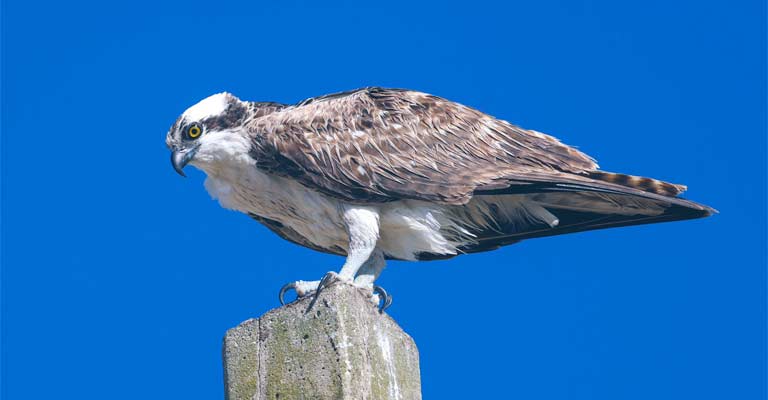
Physical Characteristics of Osprey
Identifying the Osprey (Pandion haliaetus) involves a nuanced understanding of its distinctive physical characteristics, as this raptor possesses features that set it apart within the avian world.
Here are eight key points to help in the identification of the Osprey:
Size and Shape
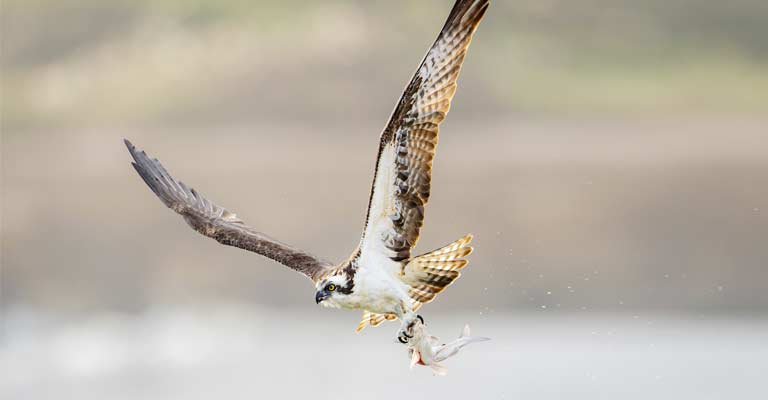
Ospreys are medium to large raptors, with a wingspan ranging from 5 to 6 feet. Their body length is approximately 21 to 24 inches.
The Osprey’s overall structure is characterized by a robust body, long wings, and a distinctive silhouette with a crook or kink in its wings when in flight.
Plumage
Adult Ospreys display a striking contrast in plumage. Their heads and underparts are predominantly white, while the upper parts, including the wings and back, exhibit a dark, almost black, coloration.
This sharp division in coloration aids in easy identification, especially during their characteristic hunting flights.
Facial Features
The facial features of Ospreys are distinctive. They possess a dark eye patch that extends to the nape of the neck, creating a distinctive “mask” appearance.
This dark facial marking contrasts sharply with the white plumage, contributing to their unique and easily recognizable visage.
Wing Characteristics
Ospreys have long and pointed wings, perfectly adapted for their aerial pursuits. One key feature is the presence of dark patches at the wrists of their wings, visible from both above and below during flight.
These patches are a helpful field mark when observing them in action.
Eye Color
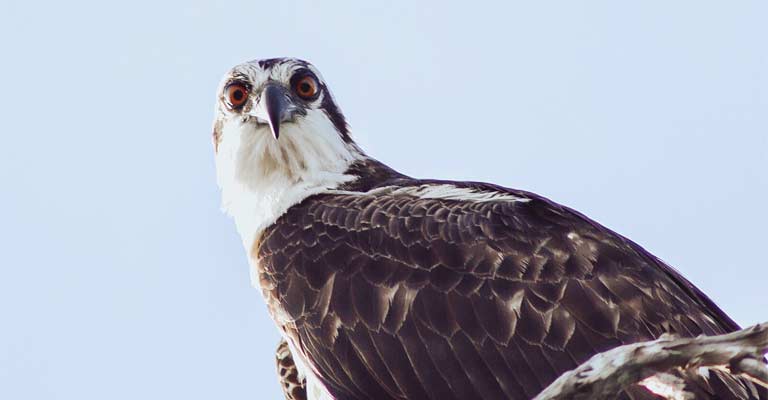
The eyes of Ospreys are a distinct yellow or golden color. This vibrant eye color is highly visible against the dark facial markings and contributes to their keen eyesight, a crucial asset during their hunting endeavors.
Reversible Outer Toes
Adapted for their piscivorous lifestyle, Ospreys possess reversible outer toes.
This unique trait allows them to grasp fish securely by reversing two of their toes to have three pointing forward and one backward, enhancing their ability to carry fish in flight.
Underwing Markings
When soaring or hovering, Ospreys display a characteristic “M” or “W” pattern on the undersides of their wings.
These markings are created by the contrast between the dark flight feathers and the lighter coverts, providing another helpful identification feature.
Voice
Ospreys are not particularly vocal, but they emit a series of distinctive whistles and chirps. These vocalizations are often heard during the breeding season and serve as an auditory cue for their presence in the vicinity.
Recognizing the Osprey involves a comprehensive understanding of its physical attributes, from plumage patterns and facial features to wing characteristics and unique adaptations for hunting.
Observing these key points in the field enhances the birdwatching experience, allowing enthusiasts to appreciate the elegance and specialization of this remarkable raptor.
Taxonomy of Osprey
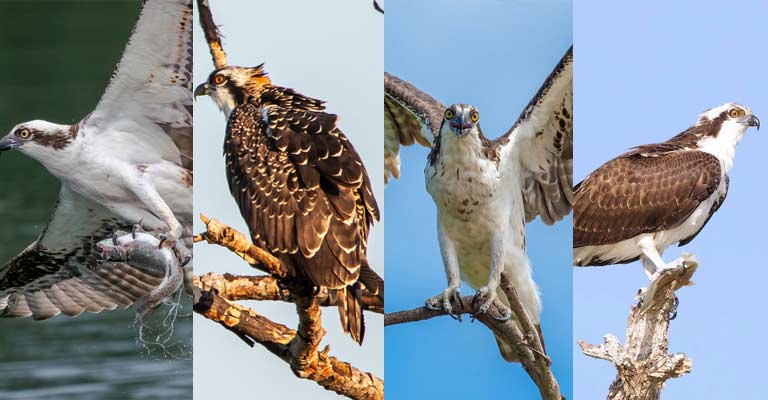
Here are all the details of the Taxonomy of Osprey:
| Taxonomic Level | Classification |
| Domain | Eukaryota |
| Kingdom | Animalia |
| Phylum | Chordata |
| Class | Aves |
| Order | Accipitriformes |
| Family | Pandionidae |
| Genus | Pandion |
| Species | P. haliaetus |
This table outlines the taxonomic details of the Osprey (Pandion haliaetus) within the broader classification hierarchy, emphasizing its place within the animal kingdom and the avian class.
The Osprey’s taxonomic classification reflects its unique position as the sole member of the Pandionidae family.
The Osprey (Pandion haliaetus), often referred to as the “fish hawk” or “sea eagle,” encompasses several distinctive subspecies, each adapted to specific regions. Let’s explore the unique characteristics of these Osprey variants:
Pandion haliaetus ridgwayi
Also known as the Ridgway’s Osprey, this subspecies is native to the Caribbean region, displaying adaptations to the island ecosystems. Its plumage and behaviors may showcase variations influenced by the specific conditions of its habitat.
Pandion haliaetus cristatus
The Cristatus Osprey, found in parts of South Asia, reflects adaptations to the diverse landscapes of its range. Its name suggests crested features, possibly referring to distinct plumage characteristics.
Pandion haliaetus haliaetus
The nominate subspecies, often found in Europe and Asia, showcases the typical features of the Osprey. Its migratory patterns and behaviors align with the broader characteristics of Pandion haliaetus.
Pandion haliaetus carolin
Known as the Caribbean Osprey, this subspecies is specifically adapted to the Caribbean islands. Its behaviors, nesting preferences, and plumage may exhibit distinctions influenced by the environmental factors unique to the Caribbean.
These subspecies demonstrate the Osprey’s remarkable ability to adapt to diverse habitats, from the Caribbean islands to South Asia and beyond.
While the core characteristics of Pandion haliaetus persist, subtle variations within each subspecies contribute to the rich biodiversity and ecological resilience of the Osprey population worldwide.
Osprey Life History
The Osprey (Pandion haliaetus), a majestic raptor often dubbed the “fish hawk,” inhabits a unique ecological niche shaped by its remarkable fishing abilities and distinctive behaviors.
This avian species, with its striking appearance and widespread distribution, unfolds a captivating life history reflecting its role as a masterful aerial predator and an indicator of environmental health.
Food
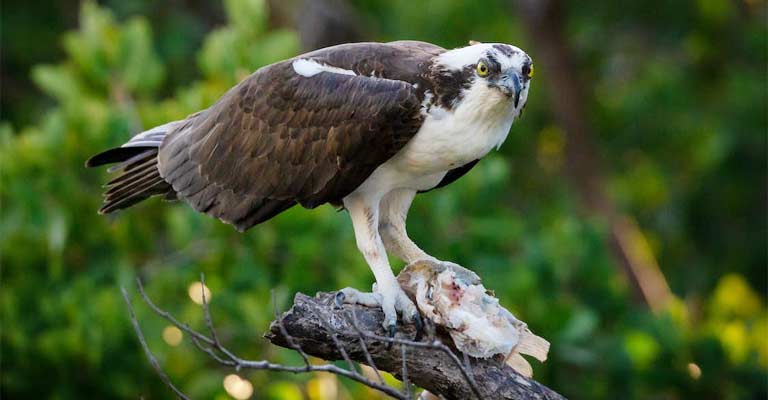
Ospreys are consummate piscivores, specializing in a diet almost exclusively composed of fish.
Their hunting techniques involve hovering over water bodies, scanning for prey with keen eyesight, and executing dramatic feet-first dives to snatch fish from the surface.
Their reversible outer toes and barbed pads on the soles of their feet aid in gripping slippery prey.
Habitat
Ospreys inhabit diverse aquatic ecosystems, including coastal areas, lakes, rivers, and reservoirs.
They demonstrate adaptability, nesting on natural structures like trees and cliffs or utilizing man-made structures such as utility poles and platforms, showcasing their ability to coexist with human environments.
Range Map
The Osprey boasts a global distribution, found on every continent except Antarctica. Their extensive range map underscores their adaptability to various climates, from the Arctic to tropical regions.
Ospreys exhibit migratory behavior, with some populations traveling thousands of kilometers between breeding and wintering grounds.
Nesting
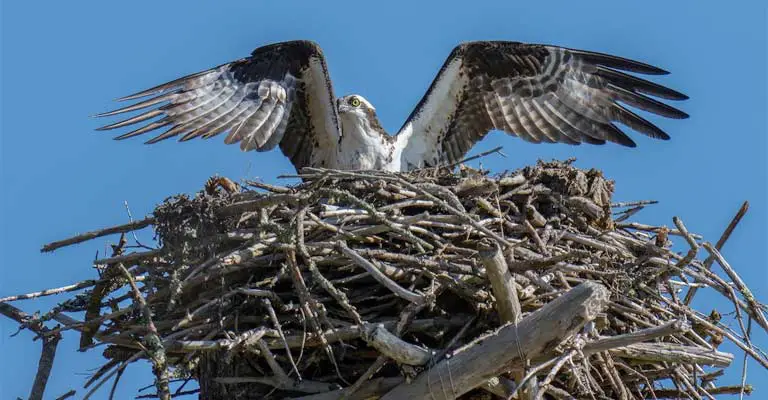
Ospreys construct large stick nests in elevated locations, such as trees, cliffs, or artificial structures. These nests serve as platforms for incubating eggs and raising offspring.
Nest sites are often reused in successive breeding seasons, highlighting their fidelity to specific locations.
| Nesting Details of Osprey (Pandion haliaetus) | Common Traits and Characteristics |
| Clutch Size | Typically 2 to 4 eggs |
| Number of Broods | Usually 1 brood per breeding season |
| Egg Length | Approximately 2.0 to 2.5 inches |
| Egg Width | Approximately 1.5 to 2.0 inches |
| Incubation Period | Around 4 to 5 weeks |
| Nestling Period | Approximately 8 weeks |
| Egg Description | Pale in color, often with blotches or speckles for camouflage |
| Nest Type | Large stick nests, situated on elevated structures like trees, cliffs, or man-made platforms |
| Nesting Site | Varied, including coastal areas, lakeshores, and artificial structures near water bodies |
| Parental Involvement | Both parents contribute to incubation and care of the young |
| Courtship Displays | Elaborate aerial displays and vocalizations to strengthen pair bonds |
| Fledgling Independence | Juveniles become independent after the nestling period |
| Re-nesting Behavior | In case of nest failure, some pairs may attempt a second brood in the same season |
| Nesting Success Factors | Availability of suitable nesting sites, prey abundance, and minimal human disturbance |
Breeding
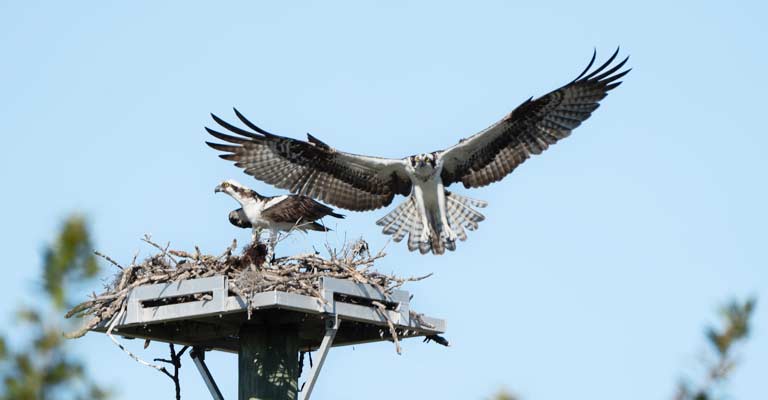
Breeding pairs engage in intricate courtship displays involving aerial acrobatics and vocalizations. Clutch sizes typically range from 2 to 4 eggs, and both parents contribute to incubation.
Ospreys demonstrate strong monogamous bonds, often returning to the same nesting site year after year.
Diseases
Ospreys can be susceptible to various diseases, including avian influenza, West Nile virus, and contaminants from polluted water bodies. Monitoring their health is crucial, especially in areas with environmental pollutants.
Treatment
In cases of illness or injury, rehabilitative efforts in dedicated wildlife centers play a vital role in the treatment of Ospreys. Veterinary care may include medical treatment, rehabilitation, and, if necessary, release back into the wild.
Conservation
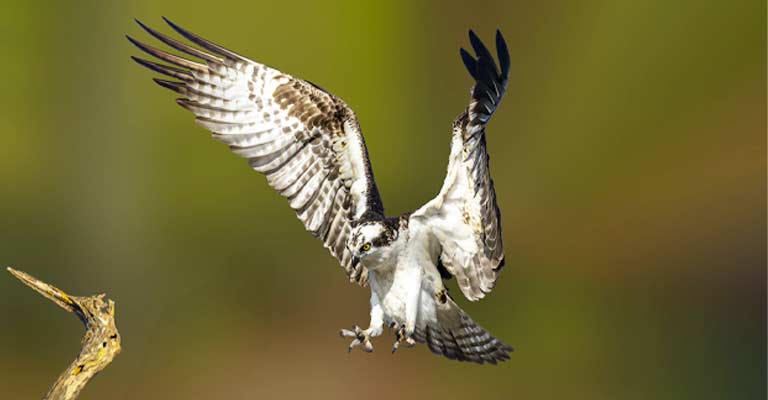
While Osprey populations have rebounded in many regions, they face ongoing threats from habitat loss, pollution, and human disturbances.
Conservation efforts focus on protecting nesting sites, managing water quality, and raising awareness to ensure the continued success of these iconic raptors.
In essence, the Osprey’s life history is a tale of adaptation, resilience, and ecological interconnectedness.
As guardians of aquatic ecosystems, they symbolize the delicate balance between human activities and the well-being of the environments they inhabit.
Understanding and conserving the life history of Ospreys is essential for maintaining the health of our planet’s waterways and the intricate web of life they support.
10 Fun Facts About Osprey
The Osprey (Pandion haliaetus), often hailed as the “fish hawk” or “sea eagle,” is a charismatic raptor renowned for its exceptional fishing skills and distinctive appearance.
As a global inhabitant of coastal and freshwater habitats, the Osprey captivates with its aerial acrobatics and fascinating behaviors.
Here are 10 fun facts that shed light on the captivating world of Ospreys.
- Specialized Fishing Talons: Ospreys are equipped with unique reversible outer toes, allowing them to grasp fish with two toes in front and two behind. This remarkable adaptation enhances their ability to secure slippery prey in flight.
- Global Distribution: Ospreys boast a worldwide distribution, found on every continent except Antarctica. Their adaptability spans diverse ecosystems, from lakes and rivers to coastal estuaries and reservoirs.
- Migratory Marvels: Ospreys are incredible migratory birds, covering vast distances between their breeding and wintering grounds. Some individuals undertake journeys of over 160,000 kilometers during their migratory cycles.
- Monogamous Mates: Ospreys are known for their strong monogamous bonds. Breeding pairs often return to the same nesting site year after year, engaging in intricate courtship displays that strengthen their lifelong commitment.
- Epic Hovering Abilities: Ospreys display exceptional hovering skills. When hunting, they can hover in mid-air, scrutinizing the water below with acute vision before executing a precise dive to snatch their prey.
- Fish-Preferred Diet: With a diet comprising almost exclusively of fish, Ospreys are consummate piscivores. They demonstrate remarkable hunting techniques, including feet-first dives into the water to secure their aquatic meals.
- Nesting Platforms: Ospreys exhibit a penchant for constructing large nests atop natural structures like trees, cliffs, and utility poles. In some areas, they readily adopt man-made nesting platforms, showcasing their adaptability to changing landscapes.
- Distinctive Plumage: The plumage of Ospreys is characterized by a striking contrast between their white heads and underparts and dark eye patches. This distinctive appearance aids in easy identification during their aerial pursuits.
- Osprey Vocalizations: Ospreys are not only visual marvels but also vocal communicators. Their melodious whistles and chirps contribute to the auditory landscape of their habitats, especially during the breeding season.
- Conservation Success: Considered a conservation success story, Osprey populations have rebounded in many regions due to conservation efforts. Monitoring and protecting their nesting sites have played a crucial role in ensuring their continued success.
In essence, these fun facts illuminate the Osprey’s extraordinary lifestyle, emphasizing its role as a global wanderer, skilled fisherman, and resilient ambassador of avian adaptation.
The Osprey’s story is one of triumph over adversity, both in its natural environment and as a beacon of successful conservation initiatives.
Wrapping Up
The Osprey emerges as a captivating symbol of nature’s ingenuity, a fish-hunting raptor that navigates the realms of sky and water with unparalleled grace.
From its distinctive appearance to its unparalleled fishing prowess, the Osprey’s life story unfolds as a testament to the intricacies of avian adaptation.
Its reversible outer toes, keen eyesight, and powerful wings embody the evolutionary innovations that have allowed it to carve a niche as a specialized piscivore.
As a charismatic indicator species, the Osprey not only mirrors the health of aquatic ecosystems but also reflects the delicate balance between human activities and environmental well-being.
The Osprey’s migratory journeys spanning continents add a global dimension to its biography, connecting diverse habitats and emphasizing the importance of international conservation efforts.
Through the lens of Osprey’s life, we gain insights into the interconnectedness of ecosystems, the beauty of aerial acrobatics, and the critical role these raptors play in maintaining the ecological tapestry of our planet’s waterways.